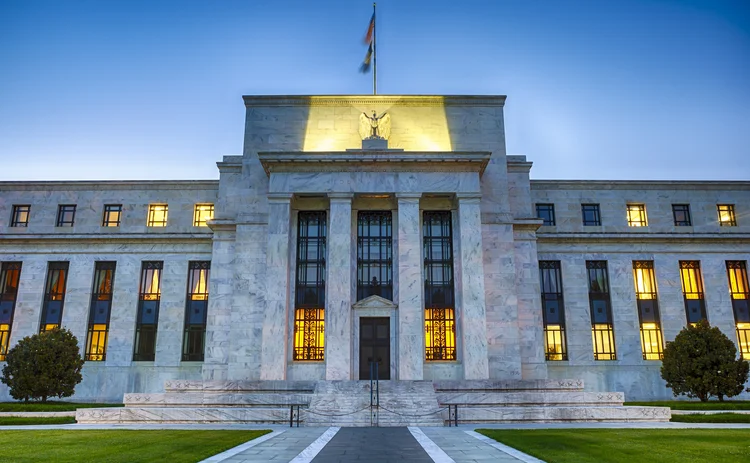
Fed cuts rates and halts balance sheet reduction
Decision sees hawkish dissents from Kansas and Boston Fed presidents Esther George and Eric Rosengren

The US Federal Reserve reduced its policy rate on July 31 for the first time since September 14, 2008, amid a global economic slowdown and muted inflation.
It also announced it will conclude its balance sheet normalisation programme in August, two months earlier than it previously indicated.
The central bank lowered its federal funds target range by 25 basis points to 2–2.25%.
The decision came with two hawkish dissents from the Kansas and Boston Fed presidents Esther George and Eric Rosengren, who voted to maintain the policy rate range.
Fed governor Jerome Powell referred to the move as “insurance” against downside risks to the outlook from trade tensions and global growth, speaking during the press conference that followed the decision.
“We are trying to address the downside risk and shortfall in inflation,” he added.
Powell said the downside risks are having a “significant effect” on incoming data on financial conditions and the real economy, and it was a “risk management” decision.
Core inflation had been 1.6% on average over the last 12 months and upward pressures remained muted, Powell added. He noted that continued below-target inflation could risk anchoring inflation expectations at a lower level.
We are trying to address the downside risk and shortfall in inflation
Jerome Powell, US Federal Reserve
Headline inflation remained at 1.4% in June, after the figure for May was revised down, well below the Fed’s 2% target. Core inflation was 1.6%, up from 1.5% in May.
GDP increased at an annual rate of 2.1% in the second quarter of this year, down from 3.1% in the first quarter. The Federal Open Market Committee projected that growth would be 2.1% for 2019 when the last forecasts were published, in June.
The employment market rebounded recently to produce a further 244,000 jobs in June, up from the marked slowdown in May of 75,000 new positions. Unemployment stayed steady at 3.7%.
On the announcement, the dollar depreciated against the euro by 0.35% from its price an hour before the statement was released. It edged marginally lower in the moments after Powell’s prepared remarks.
The dollar had depreciated against the euro in the run-up to the decision, falling by roughly 0.3% between about 1pm and 5:30pm London time, two hours before the rate decision. Investors appeared somewhat disappointed with the decision.
The S&P 500 fell by almost half a percentage point during the press conference. The Dow Jones reacted slightly more, trading down 1.2% after the press conference finished.
This article first appeared on sister website Central Banking.
Only users who have a paid subscription or are part of a corporate subscription are able to print or copy content.
To access these options, along with all other subscription benefits, please contact customer services - www.fx-markets.com/static/contact-us, or view our subscription options here: https://subscriptions.fx-markets.com/subscribe
You are currently unable to print this content. Please contact customer services - www.fx-markets.com/static/contact-us to find out more.
You are currently unable to copy this content. Please contact info@fx-markets.com to find out more.
Copyright Infopro Digital Limited. All rights reserved.
You may share this content using our article tools. Printing this content is for the sole use of the Authorised User (named subscriber), as outlined in our terms and conditions - https://www.infopro-insight.com/terms-conditions/insight-subscriptions/
If you would like to purchase additional rights please email info@fx-markets.com
Copyright Infopro Digital Limited. All rights reserved.
You may share this content using our article tools. Copying this content is for the sole use of the Authorised User (named subscriber), as outlined in our terms and conditions - https://www.infopro-insight.com/terms-conditions/insight-subscriptions/
If you would like to purchase additional rights please email info@fx-markets.com
More on Central Banks
Saxo Bank: Lagarde may declare monetary policy overreached limits
In one of its ‘outrageous predictions’ for 2020, the Danish bank says the ECB may wake up to the sad reality of negative interest rates
Cambodia extends blockchain payment system pilot
Central bank lengthens trial to end of year and explores including cross-border transactions
Central banks urged to adopt DLT-based CBDC
Industry figures argue central bank money needed for token-based securities settlement, but central bankers sceptical
Fed provides update on future RTGS system
FedNow cross-border payments could be considered in future, US central bank says
Shekel’s strength clouds Bank of Israel’s inflation outlook
Economists ponder whether central bank actions contribute to lower prices and what priorities it should consider in the near future
Central banks need better crypto asset data – ECB research
Links between crypto assets and regulated financial sector may increase and challenge regulatory frameworks
Thai central bank to work with HKMA on cross-border blockchain
Central banks to work on technology to transfer funds across borders
US Treasury designates China a currency manipulator
Renminbi crosses barrier of seven yuan per US dollar amid trade tensions on August 5
Most read
- Are market-makers better at dealing with central bank intervention?
- Navigating the T+1 implications for FX traders
- Asia FX Awards 2024: The winners








